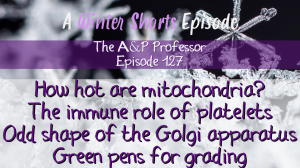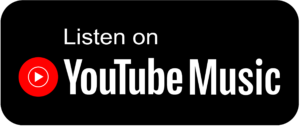Winter Short: Mitochondria, Platelets, Golgi, & Green Pens
TAPP Radio Episode 127
Episode
Episode | Quick Take
Episode 127 is one of our winter shorts, where I replay interesting segments from previous episodes. In this one, you’ll hear about the role of platelets in immunity, how the Golgi apparatus gets its weird shape, exactly how hot mitochondria get, and why we may want to consider marking assignments and tests with a green pen, rather than a red one.
- 00:00 | Introduction
- 01:07 | Mitochondria
- 02:29 | Platelets
- 07:15 | Sponsored by AAA, HAPI, and HAPS
- 08:49 | Golgi Apparatus
- 13:51 | Green Pens
- 16:20 | Staying Connected
Episode | Listen Now
Episode | Show Notes
Guess what? this is one of our winter shorts! Yep, that’s right, it’s a shorter-than-usual episode in which I present one or two, or maybe three or four, classic, evergreen segments from previous episodes that are remastered, reconstituted, and recycled for your listening and learning pleasure. But mainly it’s to give me a break for self-care over the holiday season. We’ll be back to our regular programming in late January.
Mitochondria
1.5 minute
Mitochondria run about 10 °C hotter than the other components of the cell. This number may be helpful when discussing thermoregulation, metabolism, cell biology, and more.
- Hot mitochondria? (an article in PLOS Biology) AandP.info/hw7
- This segment first aired in Teaching For Long Term Learning | Episode 7
Platelets
5 minutes
I summarize the newly described functions of motile platelets (not the sticky ones) in grabbing and bundling bacteria from a site of injury. The motile platelets then deliver the bacteria to neutrophils, which gobble up the bacteria. I offer suggestions on when (and if) one could use this information in teaching an A&P course.
- The A&P Professor blog: Platelets vs. Bacteria (Additional information and links to other sources) AandP.info/24q
- This segment first aired in Spaced Retrieval Practice | Episode 1
Sponsored by AAA, HAPI, and HAPS
90 seconds
A searchable transcript for this episode, as well as the captioned audiogram of this episode, are sponsored by the American Association for Anatomy (AAA) at anatomy.org.
The Master of Science in Human Anatomy & Physiology Instruction—the MS-HAPI—is a graduate program for A&P teachers, especially for those who already have a graduate/professional degree. A combination of science courses (enough to qualify you to teach at the college level) and courses in contemporary instructional practice, this program helps you be your best in both on-campus and remote teaching. Kevin Patton is a faculty member in this program at Northeast College of Health Sciences. Check it out!
The Human Anatomy & Physiology Society (HAPS) is a sponsor of this podcast. You can help appreciate their support by clicking the link below and checking out the many resources and benefits found there. Watch for virtual town hall meetings and upcoming regional meetings!
Golgi Apparatus
5 minutes
The Golgi apparatus has a distinctive flattened shape. It turns out that it’s the functioning of the cytoskeleton that is responsible for that shape.
- Why the Golgi Apparatus Looks So Funny (Kevin’s blog post)
- GOLPH3 bridges phosphatidylinositol-4-phosphate and actomyosin to stretch and shape the golgi to promote budding. (research article)
- Golgi’s Job Stretches it Thin (article from Science News)
- Terminologia Histologica: International Terms for Human Cytology and Histology (book plus CD)
- Terminologia Histologica: International Terms for Human Cytology and Histology (online version)
- This segment first aired in Actin & Myosin & A Love Story | Episode 15
Green Pens
2.5 minutes
It’s a small thing, for sure, but the color pen we use for grading student work can have an impact on the tone of communication in a class.
- No Red Pens! (Kevin’s blog post on this topic; with links to additional information)
- Green Felt Tip Pens
- Green Gel Pens
- This segment first aired in Give Your Course a Half Flip With a Full Twist | Episode 6
People
Production: Aileen Park (announcer), Andrés Rodriguez (theme composer, recording artist), Rev.com team (transcription), Kevin Patton (writer, editor, producer, host)
Need help accessing resources locked behind a paywall?
Check out this advice from Episode 32 to get what you need!
Episode | Transcript
The A&P Professor podcast (TAPP radio) episodes are made for listening, not reading. This transcript is provided for your convenience, but hey, it’s just not possible to capture the emphasis and dramatic delivery of the audio version. Or the cool theme music. Or laughs and snorts. And because it’s generated by a combo of machine and human transcription, it may not be exactly right. So I strongly recommend listening by clicking the audio player provided.
 This searchable transcript is supported by the
This searchable transcript is supported by the
American Association for Anatomy.
I'm a member—maybe you should be one, too!
Introduction
Kevin Patton (00:00):
Guess what? this is one of our winter shorts! Yep, that’s right, it’s a shorter-than-usual episode in which I present one or two, or maybe three or four, classic, evergreen segments from previous episodes that are remastered, reconstituted, and recycled for your listening and learning pleasure. But mainly it’s to give me a break for self-care over the holiday season. We’ll be back to our regular programming in late January.
Aileen Park (00:34):
Welcome to The A&P Professor, a few minutes to focus on teaching human anatomy and physiology with a veteran educator and teaching mentor, your host, Kevin Patton.
Kevin Patton (00:48):
This episode gives 10 things we forget to tell our students about cells, how to forest bathe in our office, getting my winter shorts ready, and when to teach the urinary system.
Mitochondria
Kevin Patton (01:07):
Today’s lucky number is 10. Why 10? Well, it turns out that there’s some information just published that suggests it’s quite possible that the temperature difference between mitochondria and the rest of the cell, the rest of the body, is about 10 degrees Celsius. So 10 for 10 degrees. That’s a little bit of information that isn’t central to our understanding of human anatomy and physiology but we certainly talk about the fact that mitochondria do produce heat and a lot of it. That helps us explain thermoregulation in the body. It helps us explain how muscles when they’re mitochondria, which they have bajillions of, are really cranking, that’s going to possibly overheat the body and we’re going to have to turn on our cooling system to get it to cool down or take various behavioral strategies to cool things down.
When we’re too cold, we can start shivering our muscles and doing other muscular activity to kick those mitochondria in gear and get our body temperature warmer than it was before. So, 10, a little number we can stick in our pocket and pull out sometime when we’re telling the story of metabolism or thermoregulation or homeostasis or who knows what.
Platelets
Kevin Patton (02:29):
Platelets. We all know about platelets, right? There’s billions of these tiny little cell fragments, something like 750 billion of them circulating around in the human bloodstream. And we know that they have broken off from a much larger body of cell called a megakaryocyte. And, as they travel around the bloodstream when an injury occurs in a blood vessel. The collagen in the vessel wall is exposed and that causes some of the platelets to become sticky and as they stick to the collagen and start piling up, they form a platelet plug. Which, helps stem the flow of blood. But it also, along with some other chemical pathways, triggers a whole cascade of reactions that eventually, results in a blood clot.
Now that’s the story we all tell in our class, right? But did you know, that they have other helpful jobs, too? One of those that was recently outlined in the literature, is that they can round up bacteria and literally feed them to our immune cells, which in turn, can devour the bacteria and help make us safe.
So, we can say that platelets besides, having a role in hemostasis, have an innate immune function.
So, what are these functions that have been recently outlined? Well, to boil it down to a few simple points. One thing we can say is that, when you have a vessel injury or inflammation, platelets that contact the intact collagen, they stick together. Those are the sticky platelets we all know about. But, we now know that, platelets that do not contact collagen, are motile. They can move around. And those motile platelets, they change shape. The platelets that start out with look kind of like a fried egg when you look at them under an electron microscope. They’re kinda, flattened out and have a little bulge in them. And, they’re going to change when their motile and become sort of, an uneven half moon shape. And, it turns out that, that half moon shape helps them better navigate the strong, sheering forces that exist in the flowing blood.
And not only that, but these motile platelets, they can even navigate upstream. That is, they can go against the flow of blood. Now, that’s something I didn’t expect to see but well, you know. We’re always finding new and amazing things about how our body works.
Another thing that the researchers found is that these motile platelets, they use mechanical force that is the force of the molecular motors in their cytoskeleton to pull particles including, bacteria from the surrounding sub straight. So, if there’s bacteria piled up on a vessel wall, at the site of an injury where there’s some inflammation going on. Those motile bacteria can go over and grab a hold of those bacteria and pull them off the sub straight.
And then, they collect those bacteria and actually, form little bundles of bacteria. So, they’re gathering up these potentially harmful bacteria. They’re bundling them up and that in turn, is going to facilitate neutrophil activation. And we know what that means, right? That means that we’re going to have phagocytosis going on. So, the immune cells, the neutrophils, are now going to be able to take those bundles of bacteria from the platelets and, gobble them up. So, that makes the whole process of what the neutrophils are doing in an inflammation response. That much more efficient, something that we didn’t really know about before.
Now, I’m not saying that we need incorporate this whole story into our course. But it might be a good thing to mention when we’re talking about platelets that “Hey, here’s their main job. But, they do other things too. For example …” Let’s put it in there. Just drop it in. Simplify it. Don’t make a big deal out of it. And then, usually a little bit later is when we run across a discussion at some level of innate immunity and, we might wanna drop it in there and mention it like. “Well, you know. We’re gonna cover some of the main mechanisms of innate immunity. But, there’s lots of other things going on in terms of, immune protection. Remember those platelets we talk about and how I mentioned that they can gather up bacteria, the ones that aren’t being involved in a platelet plug? They can gather up the bacteria and help make that phagocytosis by the white blood cells, that much more efficient?”
So, couple ways you can drop it into your course, if you want too. And, even if you don’t. Boy, it’s just an interesting story to hear about, right? And there are links to more detailed information, and the show notes and also, in the episode webpage.
Sponsors
Kevin Patton (07:15):
I know. I know. I know.
Nobody is eager for a sponsor message. But not only do federal regulations require it, believe it or not, our sponsors expect it. And they’re financially supporting this podcast so that there’s no cost to you. Yay!
Besides that, I’d be mentioning them from time to time anyway, because all three are great organizations that I’m intimately involved with and they benefit all faculty teaching anatomy and physiology. Can I say that? That I’m intimately involved? I hope that’s okay.
One of our sponsors is AAA, the American Association for Anatomy. Check out all the resources and membership information at anatomy.org
Another sponsor is the Master of Science in Human Anatomy & Physiology Instruction, the HAPI degree. Check out this online graduate program at Northeast College of Health Sciences at northeastcollege.edu/hapi, that’s H A P I.
And rounding out our sponsor list is HAPS, the Human Anatomy & Physiology Society. You can check out resources and membership information online at theAPprofessor.org/haps, that’s H A P S.
Golgi Apparatus
Kevin Patton (08:49):
Did you ever wonder why the Golgi apparatus looks so odd compared to other membranous organelles of the cell? I mean, really? Wouldn’t you think that the forces causing other membrane bound structures to form more of a globular shape would also cause the sacs of the Golgi apparatus to be more, well, round? A number of years ago, the journal Cell, published an article that answers that question. And it revealed a really cool mechanism resulting from the primary function of the Golgi apparatus.
As we know, the Golgi apparatus processes and packages proteins that arrive from the endoplasmic reticulum, or ER, by way of the ER vesicles. The central structure of the organelle is the Golgi stack, or dictyosome, which sort of resembles a stack of hollow pancakes that are kinda curved around a little bit. Golgi vesicles pinch off of the first sac, or cisterna, which is called the cis face. And then the vesicles move to the next cisterna and then the next, and finally to the final cisterna, which is called the trans face. Then a vesicle pinches off the cisterna at the trans face and moves toward the plasma membrane where it fuses and releases, or secretes, it’s content into the outside of the cell, in the process called exocytosis. Okay. So we know all that.
The new data suggests that the budding of vesicles and their movement toward the plasma membrane rely on the function of a protein called G-O-L-P-H-3, or GOLPH3. This tiny protein connects special phospholipid molecules in the Golgi membrane to myosin molecules. It’s a kind of myosin called MYO18A. This myosin, in turn, is attached to F-actin filaments of the cytoskeleton. Okay. So let me go through that again so we can picture. This is hard on a podcast when you can’t draw a picture. Okay. So what I’m saying is it’s all about a protein called GOLPH3. This tiny protein connects special phospholipid molecules in the Golgi membrane. So there are the phospholipid molecules in the Golgi membrane, to myosin molecules. These myosin molecules in turn attach to the F-actin filaments of the cytoskeleton that surround Golgi apparatus. Well, you know what that means, right? Myosin and actin connecting. Yep, you guessed it. The myosin is a motor molecule that pulls the attached Golgi membrane along the F-actin filament, so it stretches out and away from the center of the Golgi apparatus, and as it stretches it takes on it’s familiar elongated shape. And then thwaap … Yes, that’s thwaap, T-H-W-A-A-P. I guess that’s how you spell it, I don’t know. Then thwaap, a vesicle pinches off and is carried away.
So the short version of this story is, the Golgi membranes flatten out because they’re being pulled outward by the cytoskeleton in a process that produces the budding of vesicles. It’s as simple as that. So now when you’re describing this amazing little organelle in your A&P class, you have a new little twist to add to the story. And you probably already know, it’s named for it’s discoverer, Camillo Golgi, who first observed it in 1897. So remember that date, in case you’re ever on Jeopardy. Or maybe this date’s better. In 1898 is when he published it, and when he published it, a lot of scientists thought he was wrong. They thought that he was using this crazy Golgi staining process and it was creating an illusion of there being this organelle inside the cell. ‘Cause before then they didn’t really know about organelles. But then in the 20th century, when we start using electron microscopes, we finally proved that Golgi was right all along.
By the way, here’s another little interesting bit of trivia, and maybe it’ll show up on Jeopardy, you never know, or at your next trivia night. The term Golgi complex, or it’s synonym, Golgi apparatus, are among the very few eponyms that appear in the Terminologia Histologica, or TH. You probably already know that TH is the “official” list of microscopic anatomy produced by the FIPAT, that is the Federative International Program on Anatomical Terminologies. And the TH and other official lists, they tend to replace eponyms with more descriptive terms. So yay for Golgi, his name lives on, even in the TH.
Green Pens
Kevin Patton (13:51):
Okay, so here’s a really little thing, but I think it can have a big impact on the effect of our teaching on students, and that is, what color pen do you use when you’re grading papers, and marking comments on papers, and lab reports and so on. When you’re sketching out things in the margin of a student’s notebook, to help explain an idea.
If you’re like me, who began teaching during the dawn of humanity, we were all issued red pens, and that’s what we expect from teachers, right, is using a red pen. I mean, it stands out from whatever blue, or black, or whatever color pencil marks that they are making on their paper. So it’s really clear who wrote what, and the comments really do pop out.
The problem is that our students have lived part of their life already, spending decades, being corrected by teachers who had a red pen, and some of them have had some not so good experiences.
Not only that, but psychologists tell us that the color red is an alarming color. There’s a reason why fire alarms, and even fire trucks are colored in red, because it has a certain impact on our psyche.
Psychologists also tell us that the color green has a more positive impact on our psyche. It’s the dolor of nature. It’s a very peaceful color, and so for, oh gosh, it’s gotta be more than ten years, maybe twenty years now, I have avoided using a red pen, and I almost entirely use a green pen.
If you run in to me at a HAPs conference, or somewhere else, sometime, tap me on the shoulder and say, hey, can I borrow your pen for a minute, and I will pull out a green pen. Probably a felt tip, and that’s because that’s my go to color now. It stands out from what color other people are using, especially my students, so when I’m putting grades or comments on papers, I do it in green. I think it has a little bit of a positive impact, and all those little, little, little positives, that we can do in our teaching, I think add up, and add to the kind of atmosphere that we want to build in our course. That is an atmosphere of support and progress and not an alarming red kind of course.
Staying Connected
Kevin Patton (16:20):
If you don’t see links in your podcast player, go to the show notes at the episode page listed at theAPprofesssor.org/podcast. And while you’re there, you can claim your digital credential for listening to this episode.
And you are always encouraged to call in with your questions, comments, and ideas at the podcast hotline:
1.833.LION.DEN
1.833.546.6336
Or send a recording or written message to
podcast@theapprofessor.org
We’ll pivot back to fresh, full episodes in late January, when I’ll be giving my predictions for next year. If you have a prediction for where A&P instruction is headed, please send it in!
I’ll see ya down the road!
Aileen Park (17:18):
The A&P Professor is hosted by Dr. Kevin Patton, an award-winning professor and textbook author in human anatomy and physiology.
Kevin Patton (17:31):
This episode has been reconstituted from concentrate using only 100% pure electrons from a natural spring.
Episode | Captioned Audiogram
This podcast is sponsored by the
Human Anatomy & Physiology Society 
This podcast is sponsored by the
Master of Science in
Human Anatomy & Physiology Instruction 
Transcripts & captions supported by
The American Association for Anatomy. 

Stay Connected
The easiest way to keep up with new episodes is, um, wherever you already listen to audio!
Click here to be notified by email when new episodes become available (make sure The A&P Professor option is checked).
Call in
Record your question or share an idea and I may use it in a future podcast!
Toll-free: 1·833·LION·DEN (1·833·546·6336)
Email: podcast@theAPprofessor.org
Share

Kevin's bestselling book!
Available in paperback
Download a digital copy
Please share with your colleagues!
Tools & Resources
TAPP Science & Education Updates (free)
TextExpander (paste snippets)
Krisp Free Noise-Cancelling App
Snagit & Camtasia (media tools)
Rev.com ($10 off transcriptions, captions)
The A&P Professor Logo Items
(Compensation may be received)
Cite This Page
Patton, K. (2022, November 18). Winter Short: Mitochondria, Platelets, Golgi, & Green Pens TAPP 127. The A&P Professor. https://theapprofessor.org/podcast-episode-127.html
More citation formats from QuillBot Citation Generator
🏅 NOTE: TAPP ed badges and certificates can be claimed until the end of 2025. After that, they remain valid, but no additional credentials can be claimed. This results from the free tier of Canvas Credentials shutting down (and lowest paid tier is far, far away from a cost-effective rate for our level of usage). For more information, visit TAPP ed at theAPprofessor.org/education










